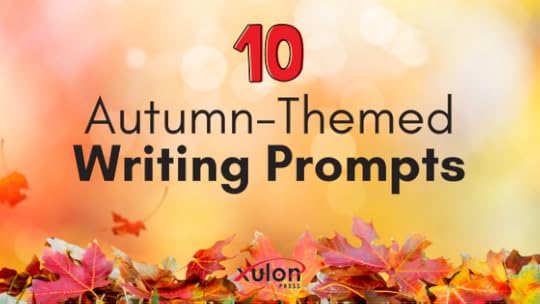Peter Lopez Jr.'s Blog: Xulon Press Blog , page 11
January 12, 2023
How to Write a Captivating Short Story

According to the Merriam-Webster dictionary, a short story is defined as an invented narrative that’s shorter than a novel, deals with a few characters, and often concentrates on the creation of mood rather than plot. A short story can come in varying shapes and sizes:
Traditional: 1,500-5000 wordsFlash Fiction: 500-1,000 wordsMicro Fiction: 5-350 wordsWriting a short story can sometimes be more difficult than writing a full novel. You have to captivate your readers, take them on a journey to a different world, and create character and story depth, all in under 5,000 words. That is why your first tip for writing a short story is that it should begin as close to the climax as possible.
Here are a few tips for writing a captivating short story:1. Give the reader at least one character they can root for.One of the easiest ways to captivate readers is through the development of a character. Develop a protagonist your readers can get invested in. This makes it easy for the reader to be quickly taken into your story’s world.
2. Suggest a backstory, don’t elaborate.As mentioned before, your short story should start as close to the end as possible. Let your readers build their own background story as their reading progresses. And when in doubt? Leave it out. You only have a limited amount of words to tell your story, make sure you don’t waste any overexplaining.
3. Write a catchy first paragraph.The first paragraph of your short story should quickly catch your reader’s attention. Begin with tension and immediacy. Try starting your narrative with something unusual, unexpected, an action, or a conflict.
Here’s an example:
I heard my neighbor through the wall.
Dry. Nothing sparks the reader’s imagination.
The neighbor behind us practices scream therapy in his shower almost every day.
This catches the reader’s attention. Who is this guy who goes in his shower every day and screams? Why does he do that? What, exactly, is “scream therapy”? Let’s keep reading…
4. Evoke an emotion.The most effective short stories are the ones that capture the reader through emotions. What will evoke deep emotions in the reader? Maybe…
LoveRedemptionJusticeFreedomHeroic sacrificeHope5. Read as many great short stories as you can find.You learn this genre by familiarizing yourself with the best. Read, evaluate, and analyze the experts, then try to emulate their work. Reading a couple dozen short stories should give you an idea of the right structure and style you should be aiming for. It should also inspire you to try one of your own.
Extra Tips for Shortening Your StoryWrite just enough to trigger your reader’s mind. Let them come up with the missing pieces with context clues.Eliminate portions that just get your characters from one place to another. The reader doesn’t care how they got there, so you can simply write: “Late that afternoon, Susie met Josh at a coffee shop…”Eliminate portions that are pure description. Instead of wasting word count to describe one of the chilliest mornings of the year, you can layer that bit of sensory detail into the narrative by showing your character covering his face with a scarf against the frosty wind.More shortening examples (items not bolded should be excluded):
She shrugged her shoulders.
He blinked his eyes.
Susie walked in through the open door and sat down in a chair.
The crowd clapped their hands and stomped their feet.
Do you have a short story worth sharing? Are you an aspiring author? Well, you’re in luck! We are offering THREE writers the opportunity to be PUBLISHED for FREE just for sharing a short story with us! Learn more about our Christian Writers Awards writing contest by clicking here.
The post How to Write a Captivating Short Story appeared first on Xulon Press Blog, Christian Self-Publishing.
January 10, 2023
How to Stick to Your New Year’s Writing Goals

New Year, new book! If you’re an aspiring author determined to publish in 2023 or a writer just wanting to increase their productivity, this list of tips is for you. Here are 5 ways to set and stick to New Year’s writing goals:
1. Create an action plan.Just writing down a list of goals isn’t enough this year. Take time to create an action plan for every goal you want to achieve. Be honest with yourself and make sure it’s a realistic action plan that you can stick to. The action plan should include quantifiable milestones, like hitting a specific word count by a certain date, a timeline to have a publishing deal signed, and a book launch plan set up.
2. Find the optimal writing space.Time, energy, and a good writing space are all we really need to be able to focus and be productive. A dedicated writing space signals your brain that it’s time to write every time you’re in that space. It doesn’t have to be fancy, it just needs to be a space with little distractions that allows you to emerge yourself in your writing.
3. Read, read, read.The best writers are readers! Staying on top of the new books in the market will also help you stay aware of the trends within your genre so you can keep them in mind as you’re planning your upcoming book. Not to mention, a lot of times reading a good book will give a much-needed inspiration boost to our current writing project. You want your readers to have that feeling you get when you finish reading a good story.
4. Celebrate your progress and accomplishments.Achieving your writing goals takes a lot of work and every milestone should be celebrated! Consider incorporating a reward system into your action plan as an added layer of motivation and encouragement.
5. Reevaluate and set new writing goals.Goal setting should not be a rare one-time task you do at the start of the year. Writing success requires constant reevaluation, especially because success can have a different meaning to you throughout the year. You could try doing these check-ins quarterly. Look at the writing goals that have been achieved so far and reflect on what your next steps should be. Are you on track to achieve your larger goal? Has that goal changed? Have you made progress faster or slower than expected? Are there steps you should add or eliminate in your action plan? There are a variety of questions to consider, so don’t hesitate to make changes as your writing skills grow and evolve throughout the year.
The post How to Stick to Your New Year’s Writing Goals appeared first on Xulon Press Blog, Christian Self-Publishing.
December 22, 2022
Stocking Stuffer Ideas for Writers

It’s the most wonderful time of the year again! While the craziness that typically comes with the holiday season can get stressful, giving gifts you know will bring smiles to the faces of loved ones is always fun. If you are like most, you probably leave stocking stuffers as a last thought. If this is you fear not– we have 10 stocking stuffer ideas for the writer in your life!
1. NotebookA nice thick, hardcover notebook is the perfect gift for those who like writing short stories, essays, or are needing to organize their next novel. You can find these in office supply stores or in the office section of a supermarket like Target. If you prefer online shopping you can try searching for “lined hardcover notebook” on Amazon. For a personalized touch, try searching “personalized notebooks” on Etsy!
2. Pocket NotebookThis is the perfect idea for writers on the go. You never know when inspiration might hit and having a pocket-size notebook is perfect to capture those thoughts. You should be able to find these in office supply stores and the office section of stores. Try Amazon if you prefer online shopping!
3. Gel PensA nice set of gel pens is a great idea for a stocking stuffer because these are the best pens for reducing hand stress. Gel pens are also ideal for precise writing and come in an array of colors. They typically transfer on paper smoothly and with thinner lines compared to rollerball pens.
5. Writing Prompts Card DeckTo help writers with writer’s block or simply to give some inspiration for creative writing, a writing prompt card deck or book is a great gift option. You should be able to find this with a quick search on Amazon.
6. Prayer JournalYou can find 2023 prayer journals in bookstores and the book section of stores. These not only keep you writing daily, but they will also keep you mindful and grateful in this new year.
7. Cube Timer DiceA cube timer is perfect for time management! You roll this dice and whatever it lands on tells you how long you have to stay focused on your writing until your next break. It can be 15 min, 25 min, etc. You can find these by searching “cube timer” on Amazon.
8. BookmarksWriters are typically readers, so bookmarks are a great stocking stuffer without a question.
9. Mug for WritersIf you go to your nearest bookstore or search “mug for writers” on Amazon you’ll find a lot of cute mugs with writing puns that are perfect to gift this season.
10. “Do Not Disturb” Door HangerSearch “writer door hanger” on Amazon and you’ll find writing-themed “Do Not Disturb” door hangers that are sure to get a chuckle out of the writers in your life.
Bonus Stocking Stuffer IdeasCoaster setLarge reusable waterbottleOffice organization suppliesHand warmersThe post Stocking Stuffer Ideas for Writers appeared first on Xulon Press Blog, Christian Self-Publishing.
September 27, 2022
Happy Ancestor Appreciation Day!

Happy Ancestor Appreciation Day, a day to look into your family history!
Most people can’t trace their lineage beyond a couple of past generations. That’s why every year on September 27th, Ancestor Appreciation Day comes to motivate families to gather and discuss their descent. Ancestor Appreciation Day helps reignite the importance of ancestry and is a day to feel motivated to ask questions and spend time with family.
If you are a writer then this is a perfect writing challenge for today. Take a look at the few different ways you can observe the holiday and incorporate writing into your day! Whether today inspires a poem, an essay, or even a novel–share in the comments what writing activity you participated in today!
How to Observe Ancestor Appreciation Day:Ask questions about your ancestrySpend the day with the elderly in your family and ask them questions about history. You will likely hear some new interesting stories!
Start a family recordThis record can include a family tree, famous accounts, photographs, and many more!
Spend the day with your familyThere is no better way to enjoy the history of your family than with family! You could even invite distant relatives and recount exchange family tales!
The post Happy Ancestor Appreciation Day! appeared first on Xulon Press Blog, Christian Self-Publishing.
September 22, 2022
10 Autumn-Themed Writing Prompts

Happy First Day of Fall! Fall (or Autumn) is the perfect season for creative writing. It is a time when stories come alive and there are so many places to pull inspiration from. Whether you’re just practicing writing or are starting to think about your next novel project for NaNoWriMo in November, now’s the time to feed your creativity! And what better way than with some fresh writing prompts?
No matter what kind of project you’re embarking on this season, grab your favorite pumpkin-flavored treat and get to writing!
Here are 10 autumn-themed writing prompts to get your pen moving.Write a Thanksgiving special for your favorite TV show.Create a conspiracy theory about the reason leaves change color in the fall.Turn on the radio and listen carefully to the next song that comes on. Write something about it: a story, a poem, or just describe what you heard!Challenge yourself to write an acrostic poem with the word AUTUMN. With an acrostic poem, you use the first letters of each line to spell out a word, in this case, you need to spell “autumn”.Create a fake news report that uses the word “pumpkin” at least 10 times.Write about your least favorite thing about the fall season.Write about your favorite thing about the fall season.Think about something new you want to try this Fall and write three paragraphs about it.Think of 10 words that remind you of the fall. Then pick three words out of the list and create a short story about those words!Create a tour guide with five things to do during the fall in your city.The post 10 Autumn-Themed Writing Prompts appeared first on Xulon Press Blog, Christian Self-Publishing.
February 2, 2022
5 Goals for Aspiring Authors

We have put together a list of five goals to help all of you aspiring authors who are ready to cross that finish line and make your book happen this year once and for all.
1. Writing GoalsIt’s time to make a realistic action plan you can stick to. Be honest with yourself and set a goal to hit a specific number of words on a consistent basis. And whatever you do, don’t let writer’s block stand in your way.
2. Publishing GoalsWrite down your expectations for self-publishing. Are you just trying to publish a few copies for yourself and your family? Do you want to publish several copies to sell at your church? Are you trying to catch the eye of a big-time publisher?
3. Creating a Writing Space for Max ProductivityTime, energy, and good writing space are all we really need to be able to focus and be productive. It’s important to have a dedicated writing space at home because it signals to your brain that it’s time to write every time you’re in that space.
4. Read!The best writers are readers. Be aware of the trends within your genre and keep them in mind as you are planning your upcoming book.
5. Find Your Target AudienceIf you’ve published or want to publish any work, whether it’s a novel, a blog, or an essay, you need to know your target audience. While it’s important to reach as many people as possible, you need to focus on your segment and be direct.
Bonus Goal: Create a Business PlanIf you’re hoping to turn that passion for writing into a career, having a well-thought-out business plan in place will be essential. It’s time to overcome that idea that as an author your only job will be to write.
Have you created an action plan for 2022 yet? Tell us about it in the comment section!
The post 5 Goals for Aspiring Authors appeared first on Xulon Press Blog, Christian Self-Publishing.
November 9, 2021
The Do’s and Don’ts for a Successful Writing Workshop

If you’ve decided to participate in your first writing workshop — either virtually or in person — you may be wondering what you can do to be best prepared for your time with other writers and how to make the most of that time. Since a writing workshop typically takes place with a small group of writers and a professional to oversee the activity, you’ll most likely receive specific instructions for how to prepare for the workshop.
Since you’ll be trading writing pieces with others in the class, you will need to have your writing in the best possible shape. First, make sure the piece of writing you want to take meets the length requirement. Second, ensure your writing is formatted as requested. If you’re meeting in person, you may be asked to print a specific number of copies of your work to pass around for critique. If you’re doing a virtual writing workshop, you may need to email your submission ahead of time.
Keep reading for our do’s and don’ts for a successful writing workshop:Be open and ready for feedback.Sharing your work with other creatives for the first time can be a little jarring. Make sure you are open and ready for the feedback you’ll receive. Since writing workshops are geared toward finding flaws in each writer’s work, you’ll need to be willing to accept constructive feedback from the other participants.
Don’t walk in with an ego.The worst thing you can do is walk into a writing workshop thinking you’re the alpha writer and everyone else should strive to match your greatness. Instead, go in with a level head and know that the goal is for all participants to be able to learn from each other and the group leader.
Be prepared with more than one piece of feedback for others.If you receive writing from other participants ahead of the workshop, be sure to take time to read over them and jot down multiple suggestions you may have. You’ll want to be sure you have enough thoughts to share so you can avoid repeating someone else’s suggestion.
Don’t be the harshest critic in the room.You don’t want to coddle other writers, but you also don’t want to be the harshest reviewer either. Always start with a piece of positive feedback and follow that up with a recommended suggestion. Be polite in your delivery and remember to be empathetic. You will be in the hot seat soon enough.
Be communicative.Participating in the class dialogue may feel uncomfortable at first, especially if you’re more of an introvert, but allowing your thoughts to be heard by others is an important part of your writing workshop experience. Others may agree or disagree with your thoughts, but your goal isn’t to convince everyone you’re right. Your only goal is to feel like your first writing workshop was a success, and participation is a huge part of that.
Don’t take it personally.If you start to feel overwhelmed by feedback on your own work, stop and take a deep breath and remind yourself it’s not personal. Your peers will make suggestions they feel may improve your piece. Don’t immediately shoot down suggestions; instead, let them marinate. Also, feel free to go back to specific peers during a break and ask if they mind elaborating further on their suggestions. This may help you process the suggestion better.
Be patient.Your first writing workshop may put you on a bit of an emotional rollercoaster, and all you can do is take it in stride and keep your cool. Be patient with yourself and your peers during the workshop process.
Don’t let self-doubt creep in.If competitive feelings start to creep in during your writing workshop, remind yourself that everyone has to start somewhere. You might feel someone’s writing is more advanced, but don’t let self-doubt creep in. That other person may have years of experience you’re unaware of. Stay focused on yourself and how you can improve your writing.
A writing workshop is successful as long as you walk out with information you didn’t have before participating. It’s really that easy!
Ready to take the next step with your writing? Call 1-866-381-2665 to speak with one of our Publishing Consultants. You can also follow us on Instagram, Twitter, and Facebook for more writing inspiration.
The post The Do’s and Don’ts for a Successful Writing Workshop appeared first on Xulon Press Blog, Christian Self-Publishing.
October 28, 2021
Boost Your Productivity for the Last 60 Days of 2021

As the holiday months start to wind up, we can all feel that 2021 is starting to wind down. Take a peek back at your list of goals and resolutions you made for this year. Are you as far along as you’d hoped you’d be on accomplishing your 2021 goals? If not, have no fear! You still have 60 days left in the year to make as much headway as possible. Using January 1st, 2022 as the goal mark, your last 60 days of the year start on November 2nd, 2021. Finding the right frame of mind to focus these last 60 days of the year takes focus and productivity.
We have 10 tips to boost your productivity and reach those lingering goals in the last 60 days of the year.1. Set your alarm clock for an hour earlier each morning.Who couldn’t use an extra hour every day to knock out some goals? Start setting your alarm for an hour earlier than you typically wake up. Don’t hit snooze and use that extra hour to be productive toward your remaining 2021 goals.
2. Drink more water.Avoid that afternoon slump by making sure you’re drinking enough water throughout the day. Lack of hydration can lead to a foggy brain, feeling tired, and a lack of motivation. I’m all for a quick jolt of caffeine to bring you back to life but staying hydrated can do so much more for your productivity.
3. Decide on the goals you want to finish before the end of the year.Take a red pen to your list of goals and strikethrough any you’ve already completed. Then, be honest with yourself as you examine the remaining goals. With a blue pen, circle the goals you can absolutely achieve by the end of the year. Then, take a yellow highlighter and mark the goals you can reach 50% completion. The remaining goals need to go. I’d recommend using the removed goals as your jumping-off point for 2022 goals.
4. Make your plan.Now that you know exactly what lies ahead of you for the remainder of the year, make an actionable plan with the goals you know you can attain at least a 50% achievement rate or higher. Looking at a calendar, plot out those remaining goals into smaller tasks across the last 60 days of the year. Use those smaller tasks as appointments with yourself. Don’t quit, cancel or push tasks down the line.
5. Find a support buddy.Having a partner to keep you accountable and motivated is a great way to ensure you get yourself to the finish line. Ask a friend or family member to participate in the last 60 days challenge with you or simply as a friend to be your supporter who regularly checks in on your progress.
6. Schedule “unfocus” time, too.It’s not possible to stay focused and on the task at all times and doing so can actually have the reverse effect. Take some time to figure out what your “unfocus” time will include. Maybe it’ll be a walk without music or a podcast, an adult coloring book, a meditation or yoga class. The sky is the limit for unfocusing time, as long as you take enough time to power down your brain for a bit and avoid taking in any information from outside sources.
7. Introduce a new podcast or audiobook on a topic relevant to your goals.No matter what goal you’re trying to achieve, there is a podcast or audiobook out there on that exact subject. Do some digging and find something to listen to that aligns with your biggest end-of-year goal. For instance, if one of your end-of-year goals is to start or finish writing a book, there are a multitude of great podcasts available for writers. You can also read or listen to a large library of books on writing.
8. Dedicate time to journal your progress.Sometimes, when we get to the finish line, we forget about the effort and perseverance it took to get us to our completed goals. Take some time to journal your goal progress during the last 60 days of 2021. Then, if you’re feeling behind in 2022, you can turn back to your progress journal and remind yourself that you are capable of completing your goals and resolutions.
9. Celebrate small wins.When you complete a task, or a series of tasks, allow yourself to celebrate these small victories! Bribing ourselves with small gifts and treats can oftentimes be all the motivation we need to succeed.
10. Don’t quit!No matter what, keep pushing until the very end! You may just surprise yourself with how much you can still accomplish between now and when the clock strikes midnight for January 1st, 2022.
Need help setting writing goals for 2022? Don’t miss our New Year’s resolutions section !
The post Boost Your Productivity for the Last 60 Days of 2021 appeared first on Xulon Press Blog, Christian Self-Publishing.
October 26, 2021
Gearing Up for NaNoWriMo

For writers, there is one important festivity that takes place right before the holidays. The writing event of the year — NaNoWriMo — starts November 1, and we want to make sure you’re as prepared as possible if you’re planning on participating in the 30-day sprint to a 50,000-word first draft of your next novel.
Take the remaining days of October to prepare yourself with our 10 easy steps:1. Gather your tools.Before you can participate, you have to decide what tools you’ll be using to complete your 50,000 words. First, make sure your computer is fully updated and all your files are backed up. Next, create a special folder and backup plan for your NaNoWriMo 2021 novel. If you’ve created an outline or character profiles, go ahead and save those files into your NaNoWriMo 2021 folder on your computer, as well. The less you have to hunt for your tools during your writing process the more efficient you can be. Also, think about whether you may need a new keyboard, mouse, or laptop stand to keep your computer screen at a comfortable height for all those long writing stretches.
2. Set up a special writing space.If you work from home, try to avoid using that same space to write. Writing where you work could potentially zap your creative energy, and we don’t want that for NaNoWriMo. If you can set up a 30-day writing space in your home, start pulling the items you’ll need close by and adding them to your space. If you’re tight on space inside, think about taking your writing time outside to a porch, picnic table, or even an outdoor seat at a coffee shop.
3. Get organized.Set up your writing space to make it as comfortable and inspiring as possible. Maybe add a candle, a new notebook and pen, a cozy blanket, and anything else you may want nearby. If you’re taking your writing sprints out of the house, pack a special writing bag with anything you’ll need to write away from home. That way, all you have to do is grab that bag on the way out the door.
4. Make a schedule.Now that you’ve pulled together your writing tools and have decided on a NaNoWriMo writing spot, it’s time to study your November calendar. Your mission is to write a minimum of 1,667 words every day of November to reach your 50,000-word goal by November 30. Create writing appointments for yourself for the entire month, so you always know when, where, and for how long you’ll be writing. This way, you’ll be less inclined to break one of those writing appointments.
5. Create a NaNoWriMo account (or log back in).Now it’s time to introduce yourself —or re-introduce yourself — to the NaNoWriMo website. Sign in to your account, set up your profile, declare your November 2021 project and start to review the helpful documents NaNoWriMo shares with all participants.
6. Add some flair to your social media.If you want to declare to everyone who follows your social media accounts that you’re participating in NaNoWriMo, download some flair and add them to your social media accounts. This may help you find some writing friends, too!
7. Stock up on snacks and drinks and do some meal planning.Knowing you’ll be spending a lot of time in front of your computer for the next month, take some time to stock up on your favorite writing snacks and drinks —and also water to keep you hydrated. You may want to put together a simple meal plan, even if it’s just knowing that you’ll be ordering food delivery for the next 30 days.
8. Find someone to keep you accountable.Even if you’re going the writing road alone, you can still ask a friend or family member to help hold you accountable for your writing. Ask this person to call, text, or leave you sticky notes to cheer you on during November. Having that level of support goes a long way in getting you to the finish line at the end of the month.
9. Tell your friends and family you’re participating in NaNoWriMo 2021!It’s the big reveal time! Be sure to tell your friends and family that you’re participating in NaNoWriMo for the next month. Communicate some clear “do not disturb” times for your household and redistribute any chores to free you up for more writing time in November.
10. Start writing!As soon as the clock strikes 12 a.m. on November 1, you’re an official NaNoWriMo participant!
If you need more help prepping for November, be sure to read our NaNoWriMo articles from past years.
The post Gearing Up for NaNoWriMo appeared first on Xulon Press Blog, Christian Self-Publishing.
October 7, 2021
Style Sheets 101: Why You Need One

There are several ways to keep yourself and your writing organized. One is a writer’s notebook and the other is to create and maintain your style sheet.
Keeping all your ducks in a row as you write a book is no small feat! Let’s face it, you’re trying to keep track of the tiniest details that live within 50,000 or more words. Plus, you have way more important things to figure out, like your climactic moment and how to actually end your story.
What is a style sheet?A style sheet is a document you add your preferences to regarding spelling, capitalization, and more for your manuscript. By keeping track of these little nuances, you ensure that you keep yourself consistent while writing. Plus, you’re also able to send your style sheet to your editor. This is a great way to communicate your specific style preferences to your editor so he or she knows not to override your stylistic choices with the Chicago Manual of Style rules.
What should you add to your style sheet?Here is a list of items you can keep track of on your style sheet:
SpellingOxford comma usageNumbers, times, and datesHow you treat numbersPreferred hyphenations and abbreviationsYour target age group (especially if writing for children)Any specifics you’d like to remind yourself of or communicate to your editorCan you send a style sheet to your editor?Having a style sheet to accompany your manuscript is a great way to communicate the decisions you’ve made for handling specific preferences in your book. Sending this information to your editor is incredibly helpful because you’re taking the guesswork out of the editor’s job and supplying him or her with a roadmap for choices you’ve made that may go against the traditional style found in The Chicago Manual of Style. Plus, if you include some backstory and character descriptions on your style sheet, you’ll be helping your fiction editor out a lot because he or she will be able to identify inconsistent descriptions more easily.
Style Sheets are Important for Book SeriesIf you plan to create a multi-book series, you’ll want to keep track of all the specific choices you made while writing the first one. This way you can maintain consistency throughout your entire book series. Readers will always notice small differences between books in the same series; more than you may think they would.
To learn more about editorial services offered by Xulon Press, visit our Editorial Services page or call 1-866-381-2665 to speak with one of our publishing consultants.
The post Style Sheets 101: Why You Need One appeared first on Xulon Press Blog, Christian Self-Publishing.
Xulon Press Blog
- Peter Lopez Jr.'s profile
- 8 followers



